Physical Address
304 North Cardinal St.
Dorchester Center, MA 02124
As discussed in the preceding chapter, the stomach is an active reservoir that stores, grinds, and slowly dispenses partially digested food to the intestine for further digestion and absorption. Its main secretory function is the production of hydrochloric acid. Gastric acid secretion is present on the first day of life and increases as infants become more mature. By 2 years of age, acid secretion is similar to that of adults, when corrected for body weight. Most studies indicate that the rate of acid secretion changes little after the second decade of life unless there is coexisting disease of the acid-secreting glandular mucosa, such as infection with Hp or atrophic gastritis.
Acid facilitates the digestion of protein by converting the proenzyme pepsinogen to the active proteolytic enzyme pepsin. It also facilitates the absorption of nonheme iron, vitamin B 12 , certain medications (e.g., thyroxin), and calcium, as well as prevents bacterial overgrowth, enteric infection, and possibly SBP.
The stomach also secretes lipase, intrinsic factor (IF), electrolytes (e.g., bicarbonate [HCO 3 − ], K + , and Cl − ), and mucins in addition to a variety of neurocrine, paracrine, and hormonal agents ( Fig. 51.1 ). Neurocrine agents are released from nerve terminals and reach their targets via synaptic diffusion (e.g., acetylcholine [ACh], gastrin-releasing peptide [GRP], vasoactive intestinal peptide [VIP], nitric oxide [NO], and pituitary adenylate cyclase–activating polypeptide [PACAP]). Paracrine agents are released in proximity to their targets and reach them via diffusion (e.g., histamine and somatostatin). Hormones are released into the circulation and reach their targets via the bloodstream (e.g., gastrin) (see Chapter 4 ).
Gastric mucosal integrity depends on a delicate balance between secretion of aggressive (e.g., acid and pepsin) and defensive (e.g., bicarbonate and mucin) substances ( Fig. 51.2 ). When mucosal defense mechanisms are overwhelmed, ulceration may occur. In order to reap the benefits of acid without untoward effects, gastric exocrine and endocrine secretion is precisely regulated. This is accomplished by a highly coordinated interaction among a multitude of neural, paracrine, and hormonal pathways.
As discussed in Chapter 49 , the stomach consists of 3 anatomic (fundus, corpus or body, and antrum) and 2 functional (oxyntic and pyloric gland) areas ( Fig. 51.3 ). The oxyntic gland area, the hallmark of which is the oxyntic cell ( oxys , Greek for acid), or parietal cell, comprises 80% of the organ (fundus and corpus). The pyloric gland area, the hallmark of which is the G or gastrin cell, comprises 20% of the organ (antrum). The human stomach contains approximately 1 × 10 9 parietal cells and 9 × 10 6 gastrin cells. There is debate as to whether the cardia, a transition zone of 0 to 9 mm between the squamous mucosa of the esophagus and the oxyntic mucosa of the stomach, exists as a normal anatomic structure or develops as a result of abnormal reflux (see Chapter 44, Chapter 45, Chapter 48 ). Autopsy and endoscopic studies suggest that cardiac mucosa is absent in more than 50% of the general population.
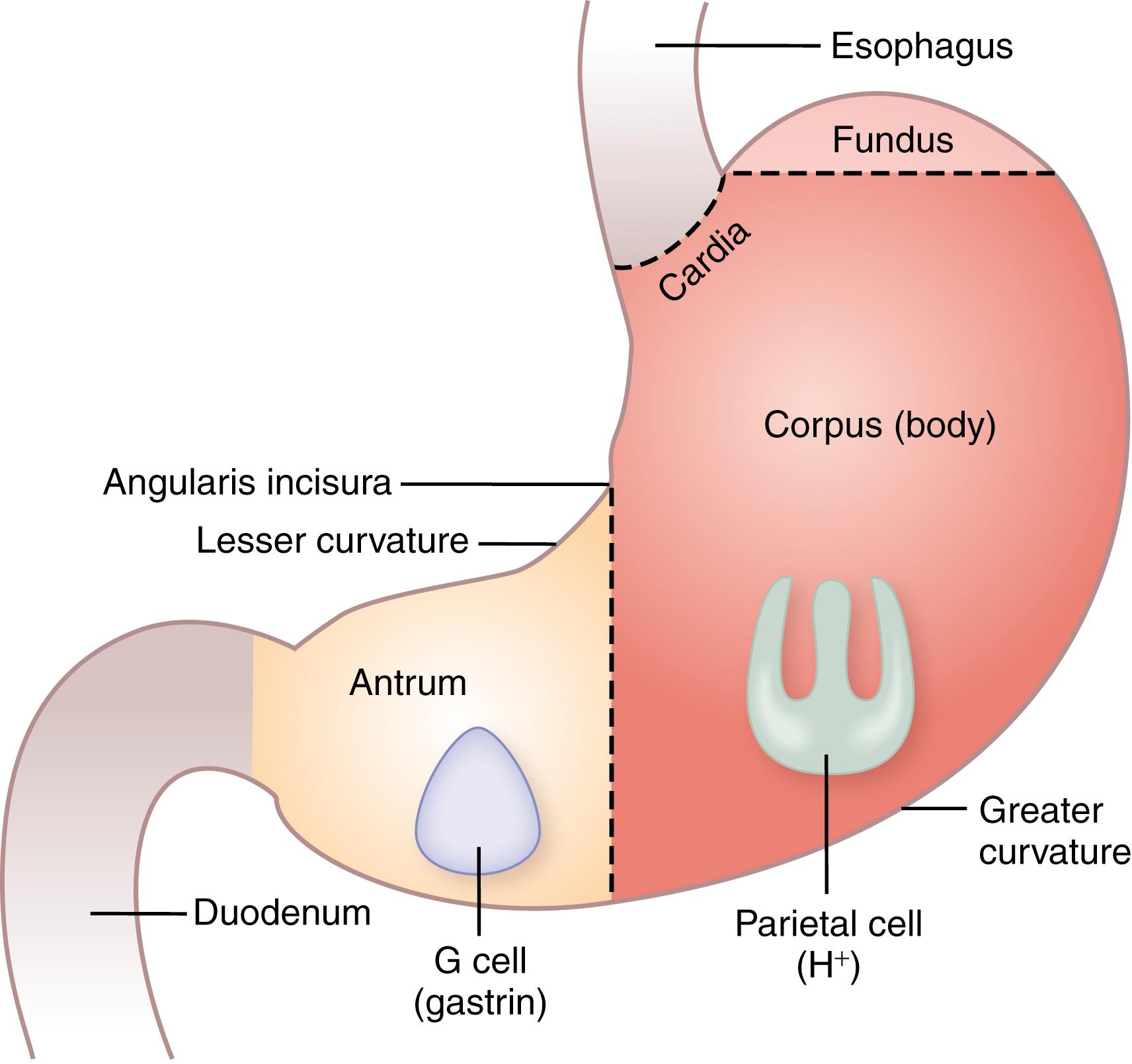
The glandular area is organized in vertical tubular units that consist of an apical pit region, an isthmus, and the actual gland region that forms the lower part of the unit; the latter consists of a neck and a base ( Fig. 51.4 ). The progenitor cell of the gastric unit, located in the isthmus, gives rise to all gastric epithelial cells. In the oxyntic gland area, the mucus-producing pit cells migrate upward from the progenitor cell toward the gastric lumen. Six acid-producing parietal cells are produced in 1 isthmus each month and migrate downward to the middle and lower regions of the gland ; as the cells migrate downward they become more senescent and are less active acid secretors. The turnover time for parietal cells is 54 days in mice and 164 days in rats. Besides hydrochloric acid, parietal cells produce IF, transforming growth factor (TGF)-α, amphiregulin, heparin-binding EGF, sonic hedgehog, hepcidin, and leptin. Chief (zymogenic) cells predominate at the gland base and secrete pepsinogen and leptin. Several distinct neuroendocrine cell types are contained within the gland, but only some of their products have been assigned physiologic functions (see Chapter 4 ). The cells include D cells (somatostatin and amylin), enterochromaffin-like (ECL) cells (histamine and parathyroid hormone–like hormone), enterochromaffin (EC) cells (atrial natriuretic peptide [ANP], serotonin, and adrenomedullin), and A-like or Gr cells (ghrelin and obestatin). Somatostatin-containing D cells possess neural-like cytoplasmic processes that terminate in the vicinity of parietal and ECL cells (see Fig. 51.4 ). The functional correlate of this anatomic coupling is a tonic paracrine restraint exerted by somatostatin on acid secretion directly as well as indirectly by inhibiting histamine secretion ( Fig. 51.5 ). ECL cells are the dominant neuroendocrine cell type in oxyntic mucosa. They constitute 66% of the neuroendocrine cell population in rats and 30% in humans. Like somatostatin-containing D cells, ECL cells may also possess cytoplasmic processes that terminate in close proximity to parietal cells.
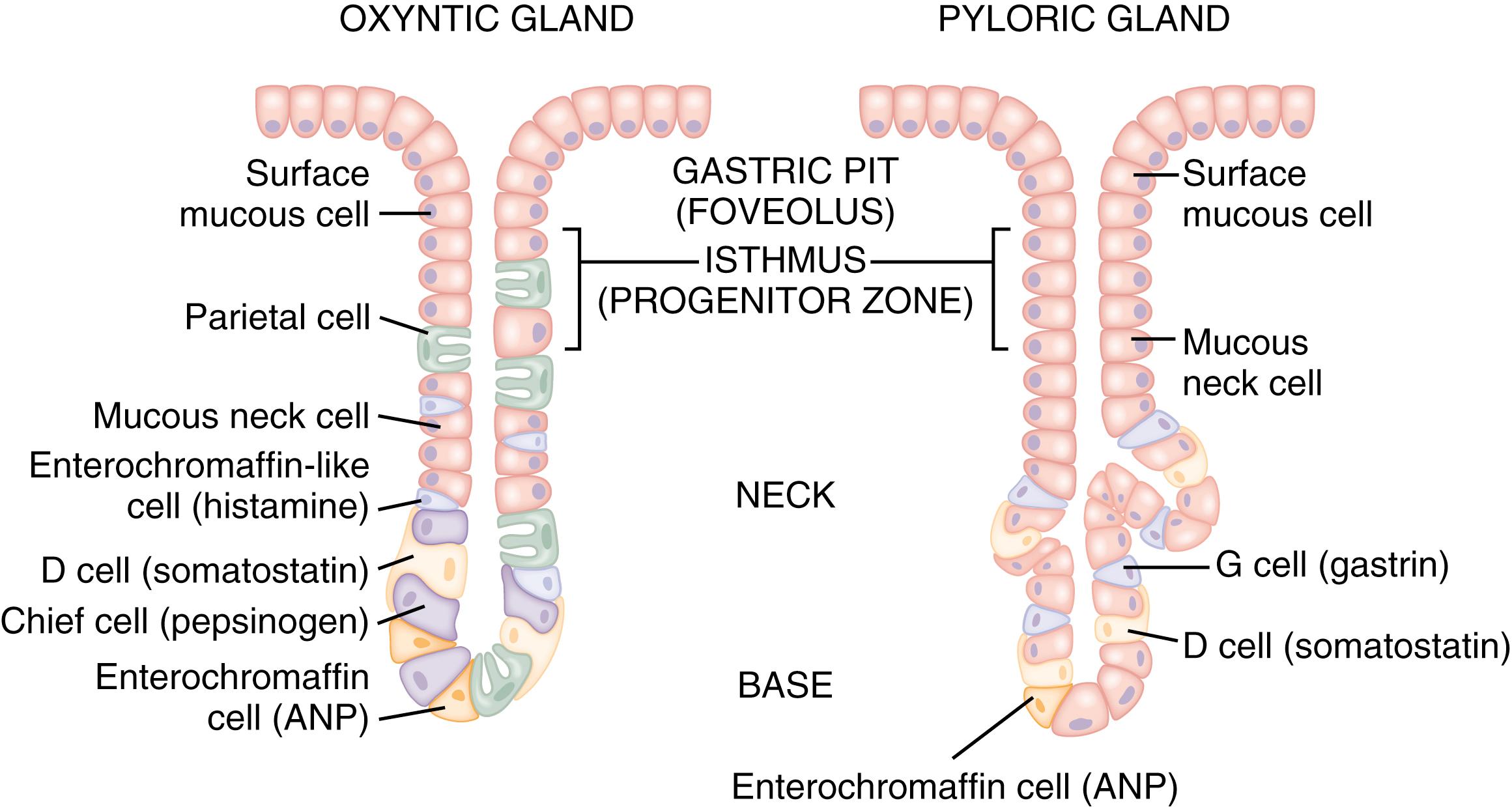
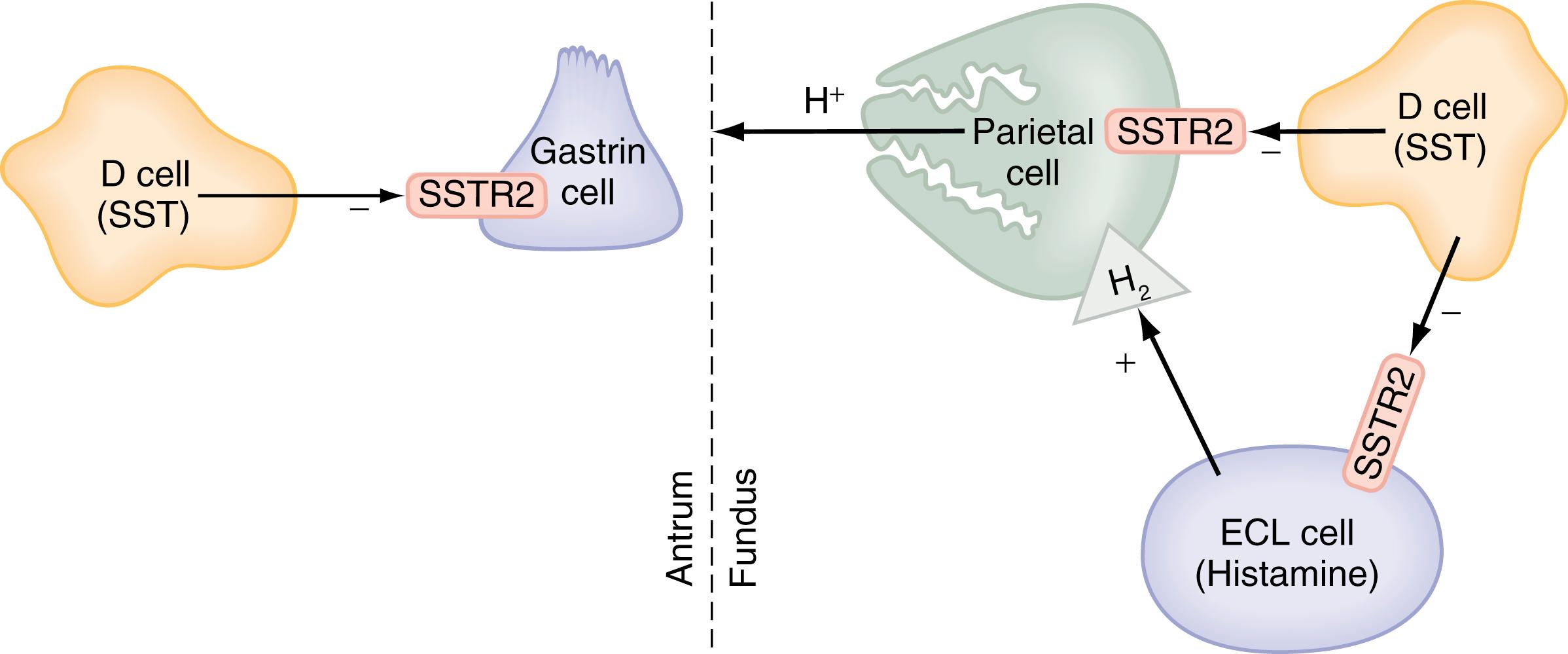
Somatostatin-containing D cells are also present in the pyloric gland area (see Figs. 51.4 and 51.5 ), where they exert a tonic paracrine restraint on gastrin secretion from G cells. , The pyloric gland also contains EC cells (ANP and serotonin), A-like or Gr cells (ghrelin and obestatin), and endocrine cells containing or-exin. , ,
Chromogranin A (CgA), an acidic glycoprotein, is contained within neuroendocrine cells and, as discussed in Chapter 34 , serum CgA has been used as a sensitive marker for the diagnosis of neuroendocrine tumors (NETs; e.g., carcinoid and gastrinoma). The bulk of “normal” blood CgA is derived from gastric ECL cells. Hence, elevated circulating CgA concentrations are also observed in patients with ECL hyperplasia caused by hypergastrinemia as a result of atrophic gastritis or treatment with PPIs for as short as 5 days. After discontinuation of PPI therapy, serum CgA gradually declines with a half-life of 4 to 5 days.
The stomach is innervated by a neural network, the enteric nervous system (ENS), which contains intrinsic neurons (i.e., neurons whose cell bodies are contained within the gastric wall) ( Figs. 51.6 to 51.8 ). The ENS, the third division of the autonomic nervous system (the other 2 being the sympathetic and parasympathetic), is often referred to as the “little brain” because it contains as many neurons (≈10 6 ) as the spinal cord and can function autonomous of central input (see Fig. 51.6 ). Nevertheless, the ENS receives input from and sends input to the central nervous system via sympathetic and parasympathetic neurons. In rats and guinea pigs, most of the intrinsic neural innervation of the stomach originates in the myenteric plexus, located between the circular and longitudinal muscle layers; the submucosal plexus in these species contains only a small number of neurons. Humans, in contrast, have a clearly defined submucosal plexus that regulates gastric secretion and contains a variety of neurotransmitters (see Figs. 51.7 and 51.8 ).
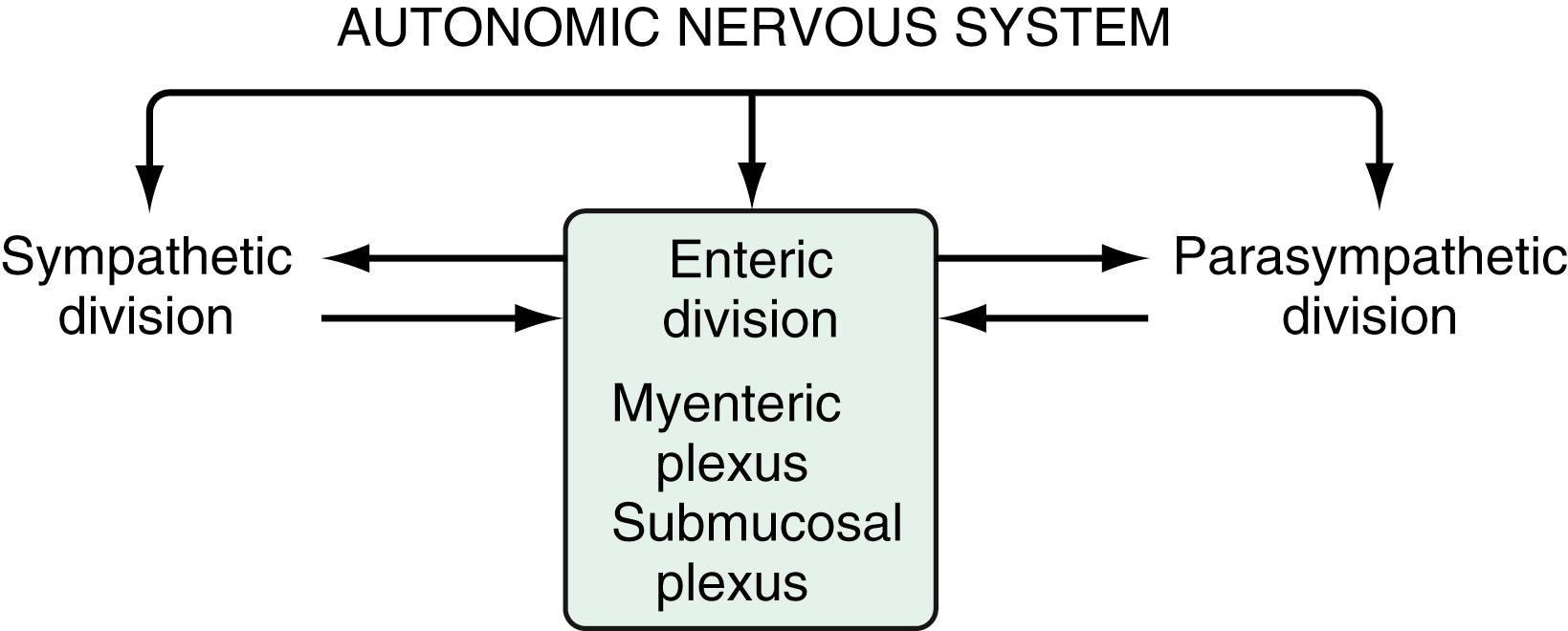
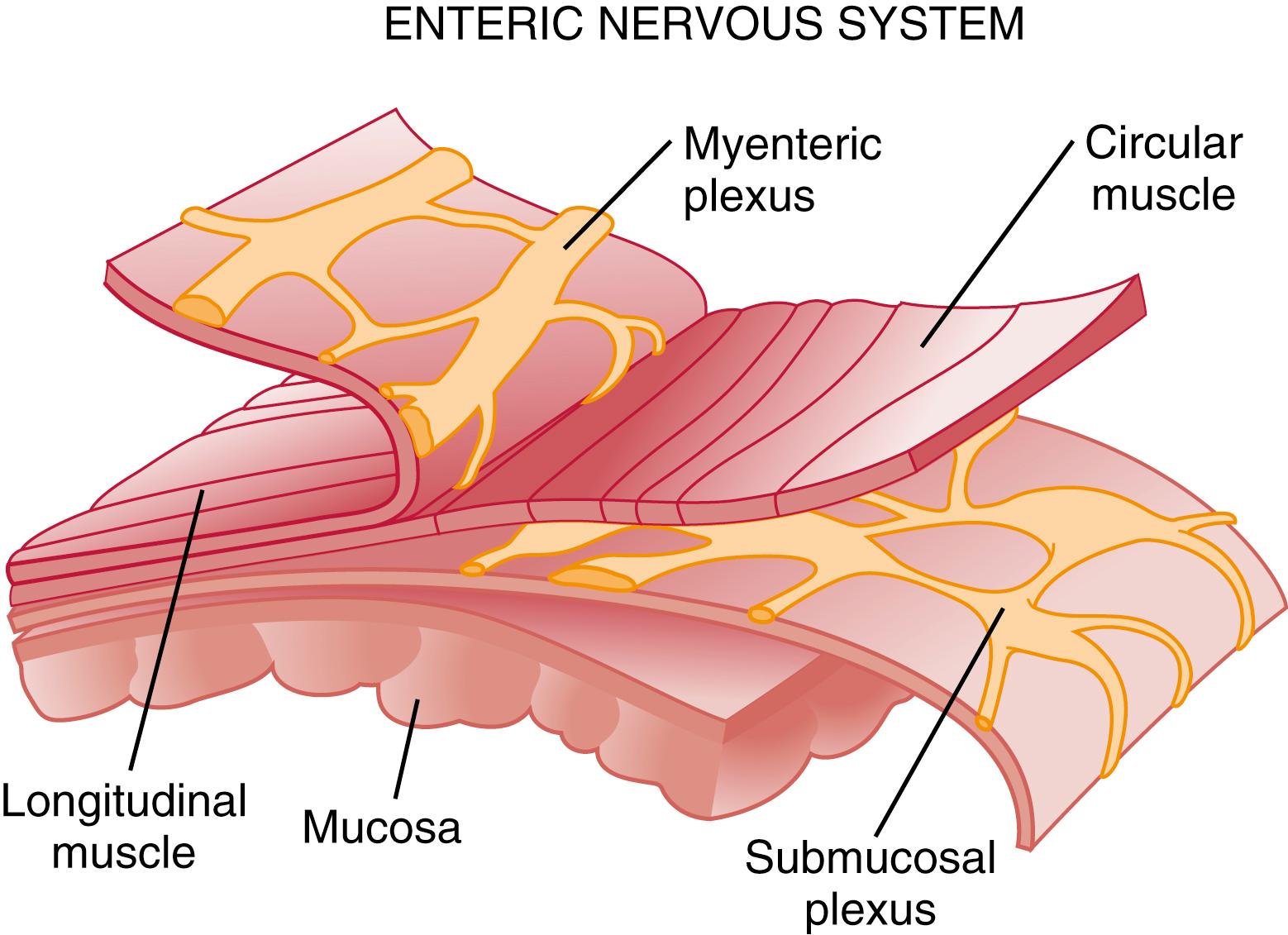
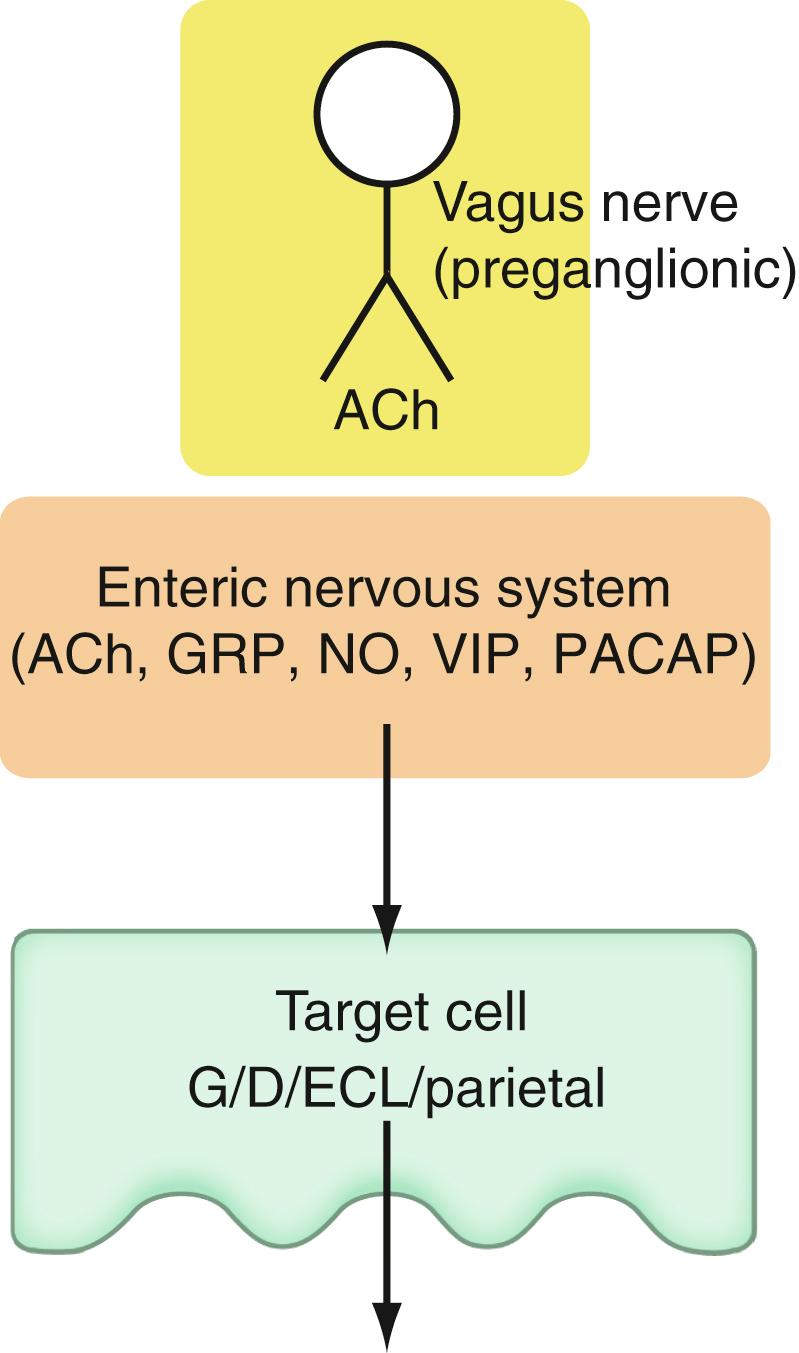
The vagus nerve is predominantly afferent, containing 80% to 90% afferent fibers and 10% to 20% efferent fibers. The efferent fibers arise from the dorsal motor nucleus in the medulla. They are preganglionic and do not directly innervate parietal or neuroendocrine cells but rather synapse with neurons of the ENS. The enteric neurons contain a variety of transmitters including ACh, GRP, NO, VIP, and PACAP (see Fig. 51.8 ). In the stomach, afferent nerve fibers containing calcitonin gene–related peptide (CGRP) are of extrinsic origin, with the cell bodies located outside the stomach wall. Neurons of the ENS regulate acid secretion directly, as is the case for ACh, and/or indirectly by modulating the secretion of gastrin from G cells, somatostatin from D cells, and possibly histamine from ECL cells (see Fig. 51.8 ).
Parietal cells secrete hydrochloric acid at a concentration of approximately 160 mM or pH 0.8. Acid is thought to gain access to the lumen via channels in the mucus layer created by the relatively high intraglandular hydrostatic pressures generated during secretion, about 17 mm Hg.
Acid facilitates the digestion of protein and absorption of nonheme iron, calcium, and vitamin B 12 , as well as prevents bacterial overgrowth, enteric infection, and possibly SBP. , However, when levels of acid (and pepsin) overwhelm mucosal defense mechanisms, ulcers occur. To prevent such damage, gastric acid must be precisely regulated and produced according to need. This is accomplished by a highly coordinated interaction among a number of neural, hormonal, and paracrine pathways. These pathways can be activated directly by stimuli originating in the brain or reflexively by stimuli originating in the stomach after ingestion of a meal, such as mechanical stimulation (e.g., distention) or chemical stimulation (e.g., protein and acid).
The principal stimulants of acid secretion are ACh, released from gastric enteric neurons (neurocrine); gastrin, released from antral G cells (hormonal); and histamine, released from oxyntic ECL cells (paracrine) ( Fig. 51.9 ; also see Fig. 51.1 ). These agents interact with specific G protein–binding receptors (M 3 , CCK-2, and H 2 , respectively) that are coupled to 2 major signal transduction pathways: intracellular calcium in the case of ACh and gastrin, and adenylate cyclase or adenosine 3′,5′-cyclic monophosphate (cAMP) in the case of histamine (see Fig. 51.9 ). There is evidence for potentiation (or synergism) between histamine and either ACh or gastrin, probably as a result of postreceptor interaction between the 2 signaling pathways. Caffeine stimulates acid secretion via bitter taste receptors (taste type 2 bitter receptors; TAS2Rs) localized to parietal cells. The main inhibitor of acid secretion is somatostatin, released from oxyntic and antral D cells (paracrine) (see Figs. 51.1, 51.5, and 51.9 Figs. 51.1, 51.5, and 51.9 ). Each of these agents acts directly on the parietal cell as well as indirectly by modulating the secretion of neuroendocrine cells ( Fig. 51.10 ).
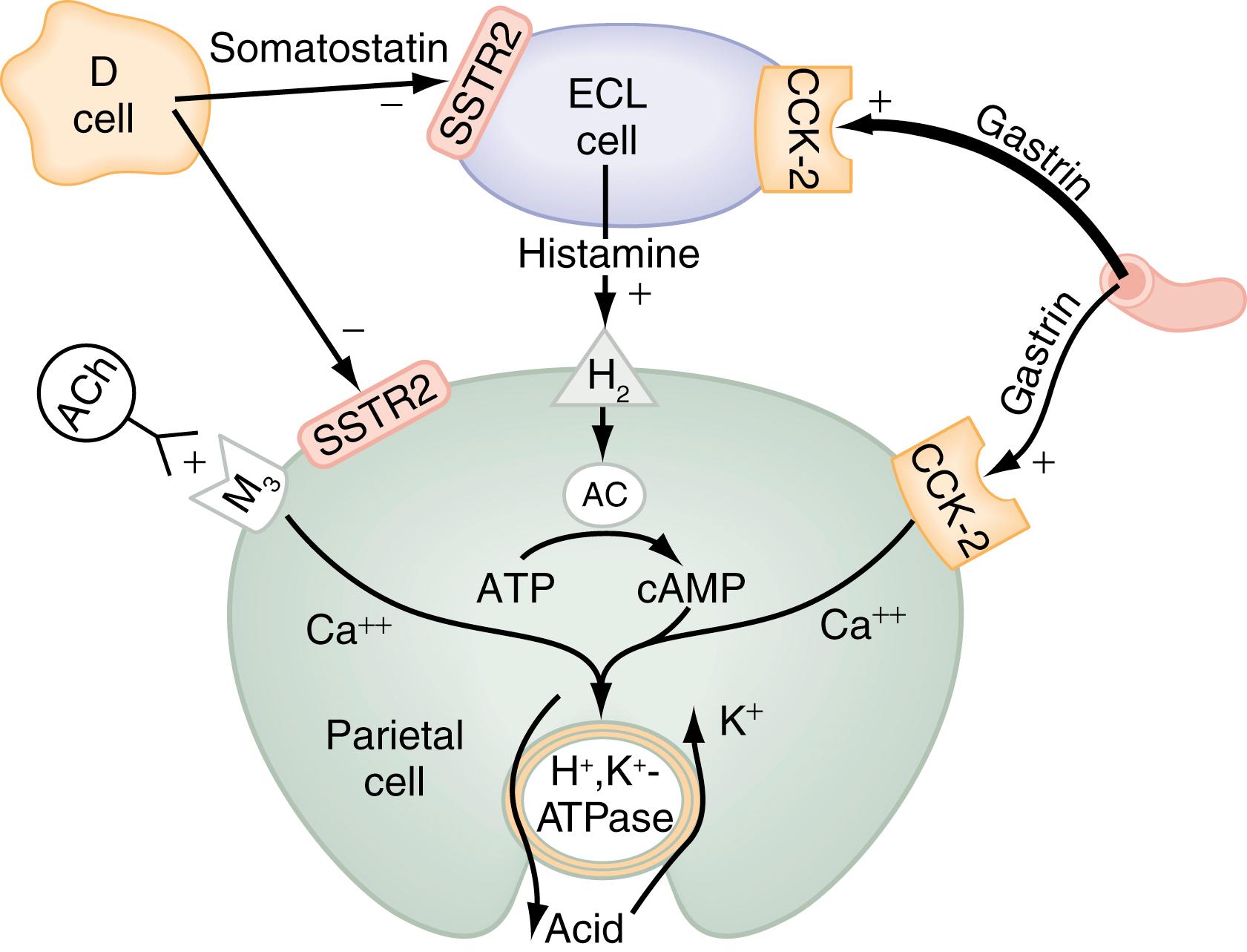
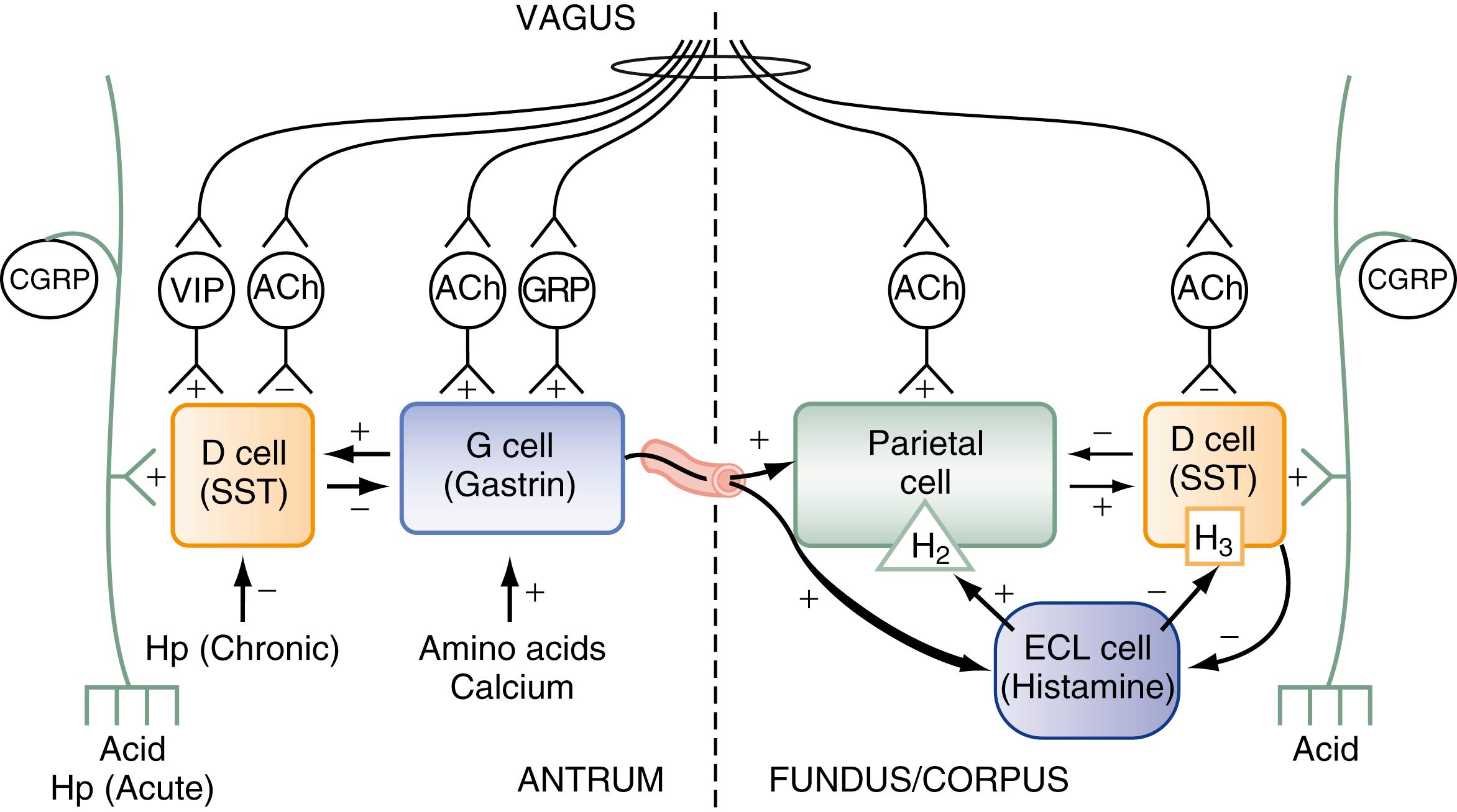
Histamine, produced in ECL cells by decarboxylation of l -histidine by histidine decarboxylase (HDC), stimulates the parietal cell directly by binding to H 2 receptors coupled to activation of adenylate cyclase and generation of cAMP (see Fig. 51.9 ). Histamine also stimulates acid secretion indirectly by binding to H 3 receptors that inhibit somatostatin release from oxyntic D cells (see Fig. 51.10 ). , Gastrin, PACAP, VIP, and ghrelin stimulate, whereas somatostatin, CGRP, prostaglandins, peptide YY (PYY), and galanin inhibit histamine secretion. , As discussed later, gastrin also exerts a direct proliferative effect on ECL cells. ACh has no direct effect on histamine secretion.
Gastrin, the main stimulant of acid secretion during meal ingestion, is produced in G cells of the gastric antrum and, in much lower and variable amounts, in the proximal small intestine, colon, and pancreas. Gastrin is synthesized as a large precursor molecule of 101 amino acids, which is converted to progastrin (80 amino acids) by cleavage of the N-terminal signal peptide. Progastrin is further processed to yield peptides with C-terminal glycine (i.e., G34gly and G17gly). The final processing step involves amidation to yield G34amide and G17amide. In humans, more than 95% of secreted gastrins are amidated and about half are tyrosyl-sulphated. Of the amidated peptides, approximately 85% are G17, 5% to 10% G34, and the remainder a mixture of bigger and smaller peptides (G71, G-52, G14, and G6). The plasma half-life of G34amide is 30 minutes and that of G17amide is 3 to 7 minutes; they are metabolized primarily by the kidney and, in smaller amounts, by the intestine and liver. Because the metabolism of G17 is much faster than that of G34, most gastrin in the circulation during fasting is G34, whereas after a meal it is G17. In patients with renal insufficiency or massive small bowel resection, fasting blood levels of G17 and G34 are elevated. , The test substance pentagastrin is not a naturally occurring peptide but rather is a manufactured analog that contains the biologically active C-terminus sequence Trp-Met-Asp-Phe-NH 2 .
Gastrin and CCK belong to the same family of peptides and possess an identical carboxyl-terminal pentapeptide sequence (-Gly-Trp-Met-Asp-Phe-NH 2 ). Two main classes of gastrin/CCK receptors have been characterized: CCK-1 (formerly CCK-A) and CCK-2 (formerly CCK B or CCK B /gastrin). CCK-1 receptors are specific for CCK, whereas CCK-2 receptors recognize both CCK and gastrin with high affinity. Sulfated and unsulfated G17 and G34 possess similar affinities for the CCK-2 receptor which is a classical G protein-coupled receptor. The binding of gastrin to the receptor activates phospholipase C, which hydrolyzes phosphatidylinositol 4.5 bisphosphate to inositol 1,4,5-trisphosphate (IP 3 ) and diacylglycerol. IP 3 mobilizes calcium from intracellular stores and diacylglycerol activates protein-kinase C isoforms. Gastrin, acting via CCK-2 receptors, stimulates the parietal cell directly and, more importantly, indirectly by releasing histamine from ECL cells (see Figs. 51.9 to 51.11 ). , Gastrin regulates the secretion and synthesis of histamine in a biphasic manner. The first phase involves release of stored histamine. The second phase relates to the replenishment of histamine stores and involves an increase in HDC activity followed by an increase in HDC gene transcription. H 2 receptor-, HDC-, and CCK-2 receptor knockout mice manifest decreased acid secretion, especially in response to gastrin.
![Fig. 51.11, Model illustrating the function and mechanism of gastrin as a secretagogue and trophic hormone in the stomach. Left Panel (Normal Secretory Physiology) : Gastrin, secreted into the local circulation by G cells of the gastric antrum (pyloric mucosa), is the main hormonal stimulant for acid secretion. Acting via CCK-2 receptors, gastrin stimulates the parietal directly and, more importantly, indirectly by releasing histamine from ECL cells. Histamine diffuses to neighboring parietal cells (paracrine pathway) where it binds to histamine H 2 -receptors coupled to generation of cyclic adenosine monophosphate and subsequent activation of the acid proton pump, H + /K + -ATPase. Somatostatin (SST) , secreted by D cells in the antrum, binds to SST2 receptors on G cells and exerts a tonic inhibitory paracrine restraint on gastrin secretion. During the interdigestive state, a local feedback pathway is activated whereby unbuffered luminal acid (acting via release of CGRP from sensory neurons [see Fig. 51.10 ]) stimulates somatostatin and, thus, inhibits gastrin secretion, maintaining acid secretion at economically low levels. Middle Panel (Hypochlorhydria-induced Hypergastrinemia) : When acid secretion is suppressed (e.g., by potent antisecretory medications or gastric oxyntic atrophy), there is lesser stimulation of somatostatin secretion with a reciprocal increase in gastrin secretion; patients develop hypergastrinemia. Right Panel (Chronic Hypergastrinemia) : As gastrin is also a trophic hormone, especially to the oxyntic mucosa, chronic hypergastrinemia, acting via CCK-2 receptors, induces hyperplasia of ECL cells. Increased number of histamine-secreting ECL cells is responsible for rebound gastric acid secretion observed after abrupt withdrawal of PPIs. In susceptible individuals, chronic hypergastrinemia-induced ECL hyperplasia may progress to dysplasia and, eventually, carcinoid tumor. Fig. 51.11, Model illustrating the function and mechanism of gastrin as a secretagogue and trophic hormone in the stomach. Left Panel (Normal Secretory Physiology) : Gastrin, secreted into the local circulation by G cells of the gastric antrum (pyloric mucosa), is the main hormonal stimulant for acid secretion. Acting via CCK-2 receptors, gastrin stimulates the parietal directly and, more importantly, indirectly by releasing histamine from ECL cells. Histamine diffuses to neighboring parietal cells (paracrine pathway) where it binds to histamine H 2 -receptors coupled to generation of cyclic adenosine monophosphate and subsequent activation of the acid proton pump, H + /K + -ATPase. Somatostatin (SST) , secreted by D cells in the antrum, binds to SST2 receptors on G cells and exerts a tonic inhibitory paracrine restraint on gastrin secretion. During the interdigestive state, a local feedback pathway is activated whereby unbuffered luminal acid (acting via release of CGRP from sensory neurons [see Fig. 51.10 ]) stimulates somatostatin and, thus, inhibits gastrin secretion, maintaining acid secretion at economically low levels. Middle Panel (Hypochlorhydria-induced Hypergastrinemia) : When acid secretion is suppressed (e.g., by potent antisecretory medications or gastric oxyntic atrophy), there is lesser stimulation of somatostatin secretion with a reciprocal increase in gastrin secretion; patients develop hypergastrinemia. Right Panel (Chronic Hypergastrinemia) : As gastrin is also a trophic hormone, especially to the oxyntic mucosa, chronic hypergastrinemia, acting via CCK-2 receptors, induces hyperplasia of ECL cells. Increased number of histamine-secreting ECL cells is responsible for rebound gastric acid secretion observed after abrupt withdrawal of PPIs. In susceptible individuals, chronic hypergastrinemia-induced ECL hyperplasia may progress to dysplasia and, eventually, carcinoid tumor.](https://storage.googleapis.com/dl.dentistrykey.com/clinical/GastricSecretion/8_3s20B9780323609623000515.jpg)
Although amidated gastrins had been thought to be the only forms with biological activity, glycine-extended gastrins may regulate the capacity of the parietal cell to respond to secretagogues, release histamine from ECL cells, and stimulate proliferation of colonic mucosa and colorectal cancers. , N-terminal progastrin fragments (e.g., progastrin fragments 1-35 and 1-19) have been reported to inhibit acid secretion in humans. ACh, GRP, PACAP, secretin, β 2 /β 3 -adrenergic agonists, serotonin, calcium, protein, amino acids, amines, capsaicin, and alcoholic beverages produced by fermentation stimulate gastrin secretion, whereas somatostatin, galanin, bradykinin, menin, and adenosine inhibit gastrin secretion. In addition, at least 2 negative-feedback pathways, mediated via release of somatostatin, regulate gastrin secretion. The first is activated by luminal acidity and involves sensory CGRP neurons (see Fig. 51.10 ). Low intragastric pH (high intragastric acidity) activates CGRP neurons that, via an axon reflex, stimulate somatostatin cells and thus inhibit gastrin secretion (see Fig. 51.10 ). Conversely, when intragastric pH rises (low intragastric acidity)—for example, by administrating antisecretory medications such as PPIs or by development of gastric atrophy—somatostatin secretion is not stimulated, and patients develop hypergastrinemia (see Fig. 51.11 ). There is some evidence that bacterial overgrowth induced by hypochlorhydria may also contribute to hypergastrinemia. The second negative-feedback pathway involves a paracrine action whereby gastrin directly stimulates somatostatin and thus attenuates its own secretion (see Fig. 51.10 ).
Gastrin also functions as a trophic hormone to stimulate mucosal proliferation. CCK-2 receptors have been localized to the progenitor zone in oxyntic glands, and chronic hypergastrinemia induces proliferation of ECL and parietal cells directly as well as indirectly via the autocrine or paracrine action of growth factors such as heparin-binding EGF, amphiregulin, TGF-α, metalloproteinases, and regenerating islet-derived 1 (see Fig. 51.11 ). , Rats rendered hypergastrinemic by PPI administration demonstrate a 5-fold increase in the number of ECL cells and a 1.5-fold increase in the number of parietal cells. Gastrin acts directly on ECL cells in rodents to induce hyperplasia, dysplasia, and eventually neoplasia (carcinoids) (see Fig. 51.11 ). In contrast to rodents, humans rarely develop carcinoid tumors in response to hypergastrinemia unless other factors are present, such as chronic atrophic gastritis or gastrinoma associated with multiple endocrine neoplasia type I ( MEN-I [see Chapter 34 ]). This may be because gastrin is elevated to a lesser degree and many decades of mild hypergastrinemia may be necessary to induce carcinoid tumors in humans. Because ECL cells contain somatostatin subtype 2 receptors (SSTR2), somatostatin scintigraphy with 111 indium-diethylenetriamine pentaacetic acid octreotide is the preferred imaging method to detect carcinoid tumors (see Chapter 34 ). ,
Recent studies implicate gastrin in carcinogenesis. , Gastrin and its receptor have been identified in various human gastrointestinal adenocarcinomas, including those of the esophagus, stomach, pancreas, and colon.
ACh, released from postganglionic enteric neurons, stimulates the parietal cell directly as well as indirectly by inhibiting somatostatin secretion (see Fig. 51.10 ). The parietal cell muscarinic receptor is of the M 3 subtype. Like CCK-2 receptors, M 3 receptors are coupled to activation of phospholipase C, with generation of inositol trisphosphate and release of intracellular calcium (see Fig. 51.9 ). Alcoholic beverages produced by fermentation stimulate gastric acid secretion, and this effect may be mediated via activation of M 3 receptors. ACh also stimulates acid secretion indirectly by activating M 2 and M 4 receptors on D cells coupled to inhibition of somatostatin secretion, thus removing the tonic restraint exerted by this peptide on gastrin, ECL, and parietal cells (see Fig. 51.10 ).
The main inhibitor of acid secretion is somatostatin. Somatostatin is synthesized from a 92–amino acid preprosomatostatin precursor molecule that is processed to yield somatostatin-14 and somatostatin-28. Somatostatin-14 is predominantly found in stomach, pancreas, and enteric neurons, whereas somatostatin-28 is the major form in small intestine. The half-life of somatostatin-14 is 1 to 3 minutes, and the half-life of somatostatin-28 is about 15 minutes.
In the stomach, somatostatin is contained almost exclusively in mucosal D cells, which are closely coupled to their target cells (gastrin cells in the antrum, parietal and ECL cells in the fundus/body) either directly via cytoplasmic processes or indirectly via the local circulation. , The functional correlate of this anatomic coupling is a tonic restraint exerted by somatostatin on acid secretion from the parietal cell, histamine secretion from the ECL cell, and gastrin secretion from the G cell (see Figs. 51.5 and 51.10 ). , , Removing this restraint (i.e., disinhibition or elimination of the influence of an inhibitor), by activation of cholinergic neurons, is an important physiologic mechanism for stimulating acid secretion (see Fig. 51.10 ). The biological activity of somatostatin is mediated via 6 G-protein-coupled receptors termed SSTR1-SSTR5; the SSTR2 receptor has 2 splice variants, termed SSTR2A and SSTR2B. In the stomach, the actions of somatostatin are mediated primarily via the SSTR2. Gastrin, GRP, VIP, PACAP, β 2 /β 3 -adrenergic agonists, secretin, CCK, ANP, adrenomedullin, amylin, gastric inhibitory peptide or glucose-dependent insulinotropic polypeptide, high concentrations of adenosine, CGRP, phenylalanine, tryptophan, and acute infection with Hp stimulate somatostatin secretion, whereas ACh, interferon-γ, low concentrations of adenosine, glucose, glutamine, and chronic antral infection with Hp inhibit somatostatin secretion. As mentioned, an increase in luminal acidity acts to attenuate acid secretion via a pathway involving CGRP sensory neurons with release of somatostatin in the antrum and the fundus. The change in gastric somatostatin secretion can be demonstrated over a range of pH 3 to pH 5, which is within the range observed after ingestion of a meal ( Fig. 51.12 ).
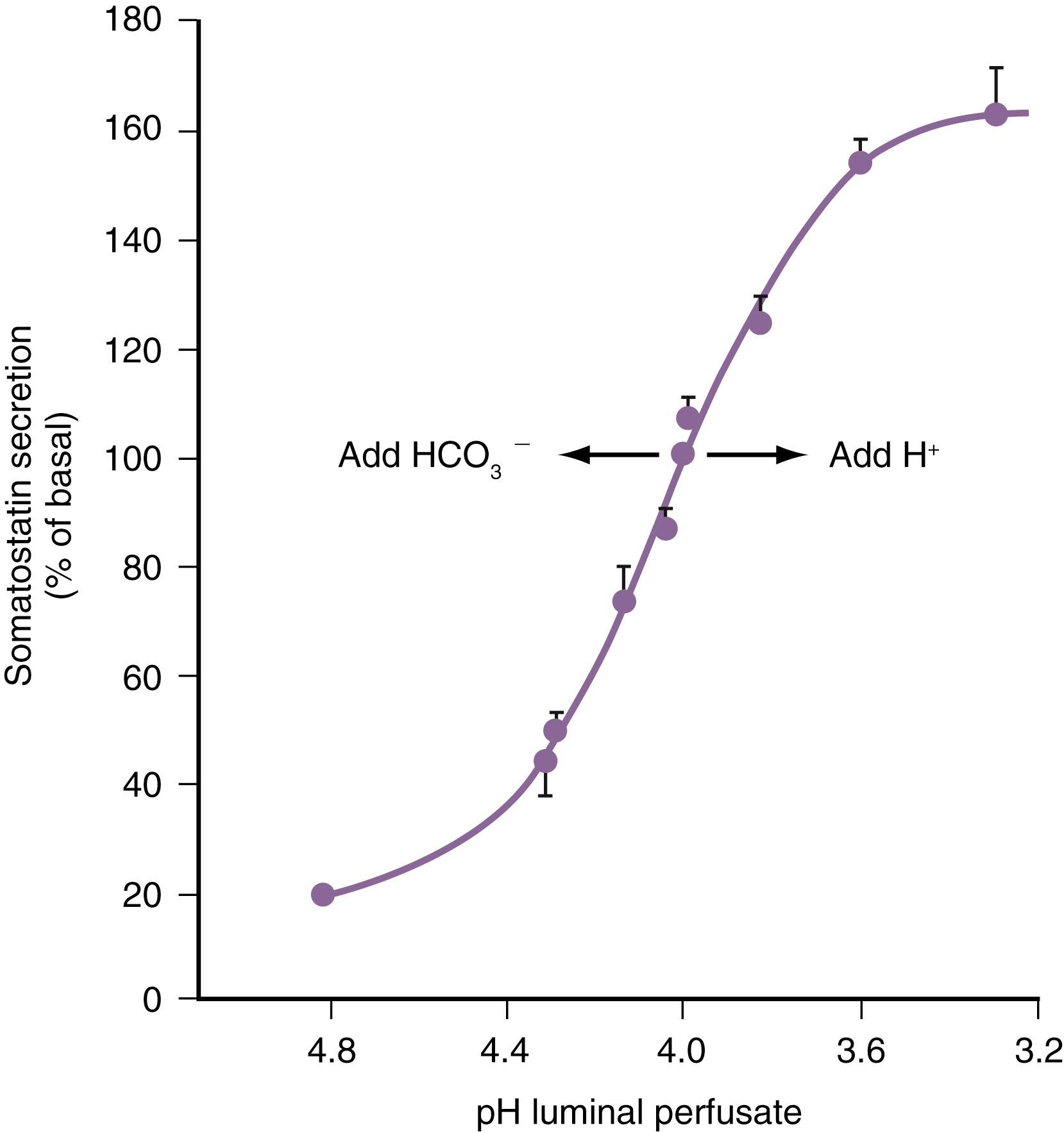
PACAP, a member of the VIP family of peptides, is present in gastric enteric neurons. PACAP functions via binding to a PACAP receptor termed PACAP type 1 receptor (PAC1) and 2 types of VIP receptors, VPAC1 and VPAC2. Acting via PAC1 receptors on histamine-containing ECL cells, PACAP stimulates acid secretion whereas, acting via VPAC1 receptors on somatostatin-containing D cells, PACAP inhibits acid secretion. , Depending upon the relative contribution of these pathways, PACAP has variously been reported to stimulate or inhibit acid secretion.
Ghrelin, the natural ligand for the growth hormone secretagogue receptor, is present in greatest concentrations in gastric oxyntic mucosa and is localized to A-like (or Gr) cells. , Lesser amounts are present in the antrum, small intestine, and colon (see Chapter 4 ). The mammalian stomach produces 60% to 80% of the body’s ghrelin and gastrectomy produces an immediate 75% decrease in plasma ghrelin. Plasma ghrelin concentrations increase before meals and decrease postprandially. It is postulated that ghrelin triggers premeal hunger and promotes feeding. Its suppression after Roux-en-Y gastric bypass may, in part, contribute to weight loss. In addition, secretin, endothelin, and cannabinoids stimulate ghrelin secretion, whereas Hp infection, GRP, CCK, insulin, glutamine, somatostatin, and interferon-γ decrease ghrelin secretion. Most studies report that exogenously administered ghrelin stimulates acid secretion. The stimulatory effect appears to involve the vagus nerve and histamine, because it is abolished by vagotomy and is associated with an increase in HDC messenger RNA (mRNA). ,
Orexin-A, derived from prepro-orexin by post-translational processing, is co-localized with gastrin in human pyloric mucosa. , Intracerebroventricular and peripherally administered orexin-A stimulate gastric acid secretion. , In rats equipped with a gastric fistula, an orexin receptor 1 antagonist inhibits basal and pentagastrin-stimulated acid secretion, implying that endogenous orexin-A stimulates acid secretion. ,
ANP, CCK, secretin, neurotensin, glucagon-like peptide 1 (GLP-1), glicentin, oxyntomodulin, PYY, adrenomedullin, amylin, glucose-dependent insulinotropic polypeptide, leptin, EGF, and interleukin (IL)-1β inhibit acid secretion. The effect of each, except perhaps for IL-1β, is mediated via release of somatostatin. , ,
The term enterogastrone has been used to describe the intestinal factor or factors responsible for inhibiting acid secretion in response to nutrients in the intestine. Prime candidates include CCK, secretin, neurotensin, GLP-1, glicentin, and oxyntomodulin, because they are present in intestinal mucosa, released into the circulation in response to luminal nutrients, and capable of inhibiting acid secretion at “physiologic” concentrations. Although it is likely that enterogastrone activity represents the combined influence of several of these peptides, the strongest evidence favors CCK (acting via somatostatin). CCK, produced in I cells in the proximal small intestine, is released by luminal protein and fat. The acid-inhibitory response to intraduodenal fat is abolished, in dogs, by pretreatment with a CCK-1 receptor antagonist and, in mice, by knockout of the CCK-1 receptor.
In parietal cells, acid secretion is increased by activation of intracellular cAMP- and calcium-dependent signaling pathways that activate downstream protein kinases, ultimately leading to fusion and activation of H + ,K + -ATPase (the proton pump), with concomitant activation of luminal membrane conductances for K + and Cl − ( Fig. 51.13 ; also see Fig. 51.9 ). The H + ,K + -ATPase actively pumps out H + , as hydronium ions, against a tremendous concentration gradient (cell interior pH 7.4 or 40 nM; acid secreted at pH 0.8 or 160 million nM) in exchange for luminal K + . The energy required comes from ATP produced by the parietal cell’s extensive mitochondrial network. H + ,K + -ATPase consists of an α - subunit that carries out the catalytic and transport function of the enzyme and a heavily glycosylated β-subunit that protects the enzyme from degradation. Both subunits are necessary for trafficking to the apical membrane, and targeted knockout of either subunit results in achlorhydria.
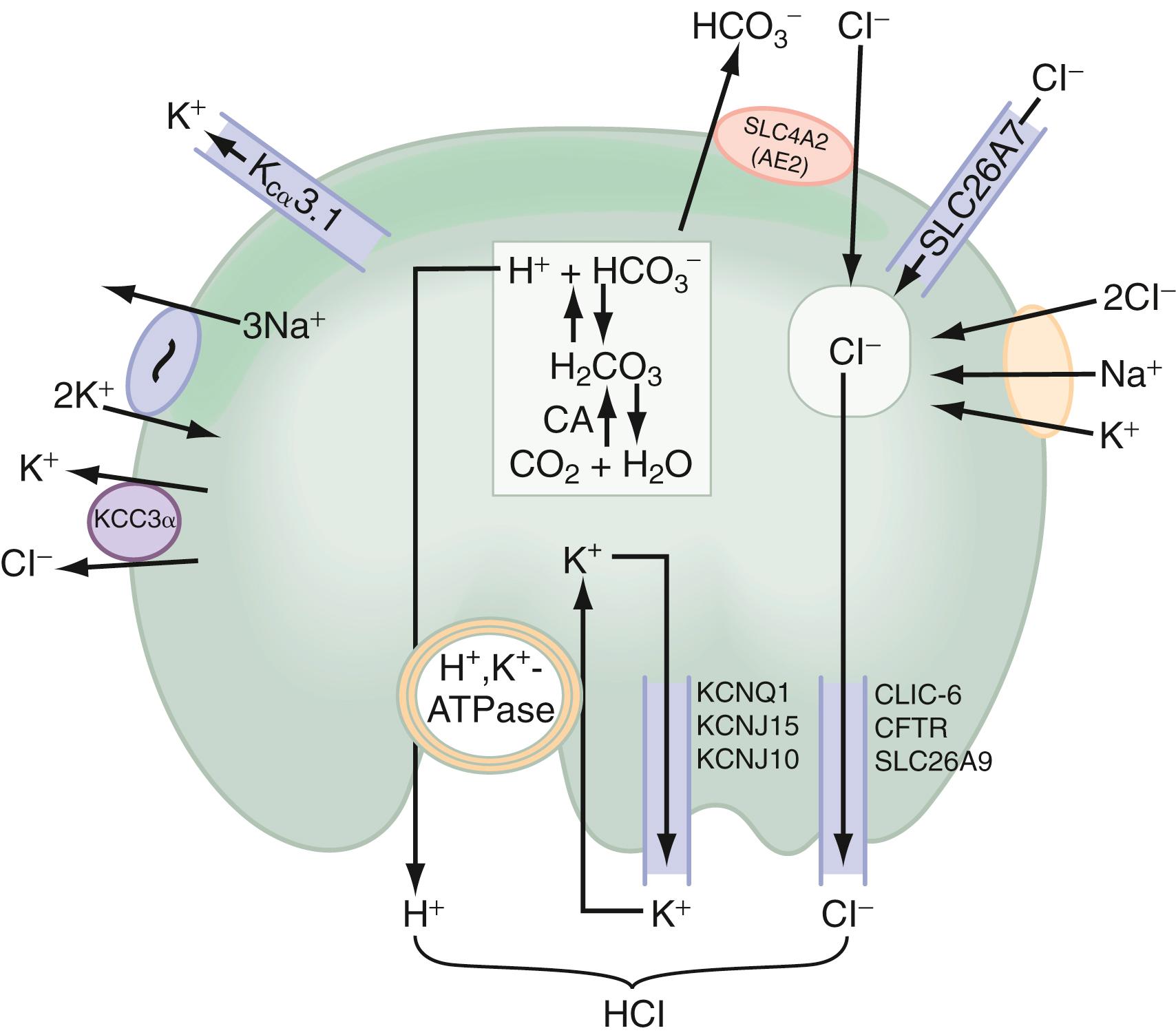
In the resting unstimulated state, H + ,K + -ATPase activity is sequestered within cytoplasmic tubulovesicles. On stimulation, there is a dramatic morphologic transformation as the vesicles translocate and fuse with the apical plasma membrane, resulting in a 6- to 10-fold increase in the membrane and the formation of the canalicular system ( Fig. 51.14 ). Translocation of the H + ,K + -ATPase into the canalicular membrane together with the presence of luminal K + activates the enzyme. On cessation of secretion, the H + ,K + -ATPase is retrieved from the apical membrane and the tubulovesicular compartment is reestablished. The precise mechanisms regulating H + ,K + -ATPase trafficking are not known, but data suggest that it involves vesicular proteins (e.g., clathrin), actin-based microfilaments, actin-binding proteins (e.g., ezrin), small G proteins of the Rab family (e.g., Rab10, Rab11, Rab25, and Rab27b), soluble N -ethylmaleimide-sensitive factor attachment protein receptor (SNARE) proteins (e.g., VAMP-2 and syntaxin 1, 2, 3 and 4), and secretory carrier membrane proteins (SCAMPs).
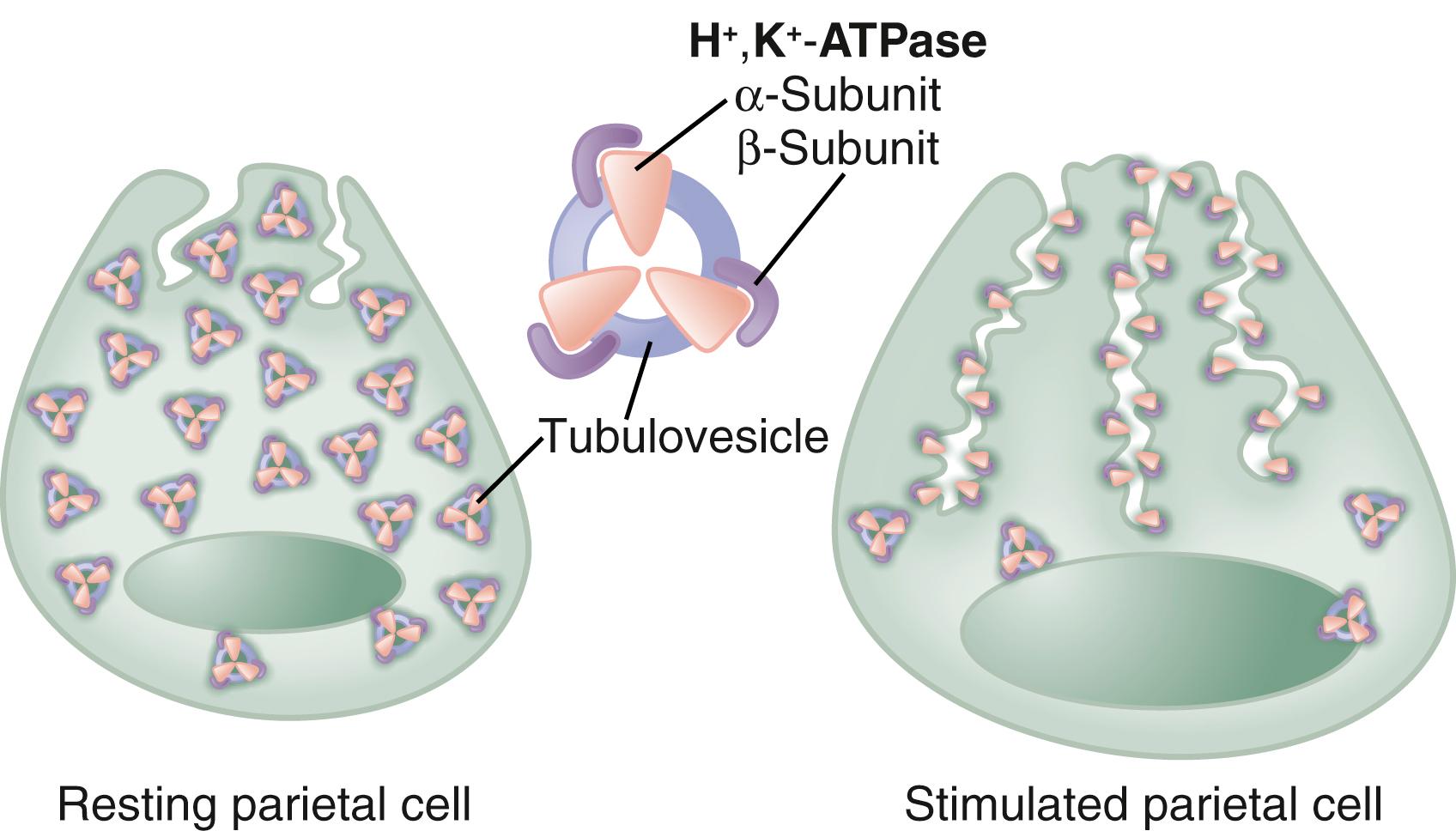
Acid secretion requires not only a functional H + ,K + -ATPase but also apical K + and Cl − channels and basolateral HCO 3 − and Cl − exchangers. Acid is produced from the hydration of CO 2 to form H + and HCO 3 − , a reaction catalyzed by cytoplasmic carbonic anhydrase (see Fig. 51.13 ). Because the H + ,K + -ATPase is unable to pump H + into the lumen without a parallel uptake of K + , sufficient quantities of K + must be delivered to the lumen. This K + recycling is accomplished by the putative luminal potassium channels KCNQ1/KCNE2, KCNJ10 (Kir4.1), and KCNJ15 (Kir4.2). , KCNQ1 is a voltage-activated K + channel that, when modified by the small regulatory subunit, KCNE2, becomes voltage insensitive, constitutively open, and acid activated. , The concentration of K + in gastric juice (8 to 12 mM) exceeds plasma K + by 2- to 4-fold. The basolateral membrane of the parietal cell may contain potassium exporters that negatively regulate acid secretion (i.e., the electroneutral K + -Cl − cotransporter, KCC3a, as well as the intermediate Ca 2+ -activated K + channel, K ca 3.1). ,
For each H + secreted, an HCO 3 − ion exits the cell across the basolateral membrane via SLC4A2, the anion exchanger 2 (AE2; see Fig. 51.13 ). As a result of this HCO 3 − /Cl − exchange, the pH within the parietal cell remains only slightly alkaline during acid secretion. Rapid entry of HCO 3 − from parietal cells into blood has been referred to as the alkaline tide . Some of this HCO 3 − may be taken up and secreted by gastric surface epithelial cells.
Concurrently with H + , Cl − is extruded across the luminal membrane via an apical chloride channel, possibly the chloride intracellular channel-6, cystic fibrosis transmembrane regulator, and/or SLC26A9 (see Fig. 51.13 ). Chloride enters the cell via the basolateral anion exchanger 2 (SLC4A2), the SLC26A7 channel, and sodium-2 chloride potassium-cotransporter-1 (NKCC1) (see Fig. 51.13 ).
Become a Clinical Tree membership for Full access and enjoy Unlimited articles
If you are a member. Log in here